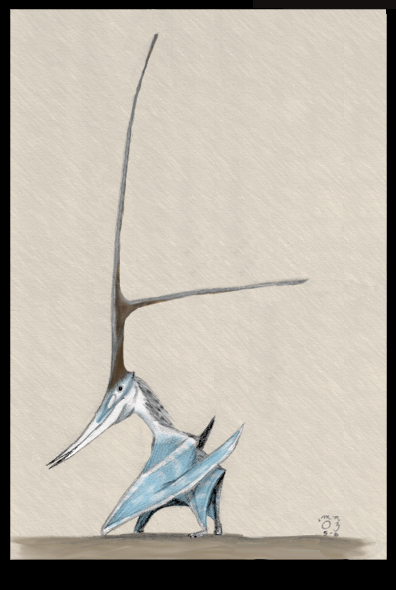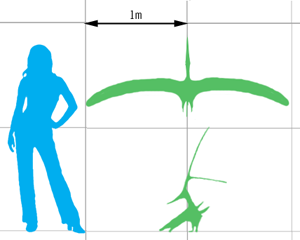home > natural history
Nyctosaurus gracilis
"slender bat lizard"

Nyctosaurus is a long-winged pteranodont that sailed the air currents over the Western Interior Seaway in the late Cretaceous period. Long thought to only have a small crest, unlike the distinctive crests of its relative Pteranodon, new discoveries prove that Nyctosaurus actually put its larger cousin to shame. At least one species sported an enormous, antler-like display that was significantly longer than its entire body.
The sheer size of this crest would have posed an obvious problem for a flying animal. A few scientists once proposed the explanation that it supported a 'sail' of soft tissue, as seen in the distantly related Tupandactylus from South America, which could have been used to wind surf over the waves while using its beak to skim food. However, this proposal was based on two popular misconceptions. First, it ignored the fact that the backward-pointing crest spar was almost the same length as the upward-pointing spar (because of one specimen where the back-pointing spar is broken off and appears shorter), creating a profile very dissimilar from a traditional sail. The first flurry of reconstructions of this animal were based solely on photos of the broken-sparred specimen, not the dimensions published in Chris Bennett's 2003 paper on the two crested specimens, and this mistake even made it into the scientific literature and at least two (obviously flawed) wind-tunnel tests of the crests aerodynamics (one of which was published in 2009 anyway).
Second, the nature of the soft tissue extensions of pterosaur crests is often misundersttod, especially by artists. When we read "soft tissue", many of us take it to mean "skin", like the membranes of the pterosaur wing. However, no pterosaurs preserve any kind of skin membrane between crest spars. Though this is often shown in artist's depictions of Tupandactylus and other tapejarids, the soft tissue extensions in all known pterosaurs are composed of stiffened structural fibers and/or keratin, not a pliable skin membrane. In tapejarids like Tupandactylus, the transition between bone and soft keratin is obvious in the fossil, with flattened bony spars having rough edges at the transition point. In Nyctosaurus, the spars are rounded, smooth, and show no signs of keratin attachments. It is theoretically possible that pteranodonts evolved a uniue skin flap on their crests (this was even proposed for Pteranodon itself in the 1970s), it would be pure speculation and contrary to what we curently know about the anatomy of pterosaur crests.
Other scientists have unofficial'y proposed other scenarios, including one where male Nyctosaurus grew the huge antlers only during mating season when they were primarily ground-bound on rocky offshore rookeries (behavior also supported by evidence from Pteranodon) and later shed their huge crests like deer. However, no shed or isolated Nyctosaurus crests have ever been found.
Aside from its spectacular crest, Nyctosaurus is notable for having reduced the bones in its wing- it has only three bones in the wing finger, and has almost lost the other three fingers all together. When walking it would have used the "stubs" of its wing to walk on, like stilts. Like other pteranodonts, Nyctosaurus lacked teeth. Instead it had a sharp, pointed beak, ideal for catching fish, as well as a pelican-like throat pouch.
Image Details:
Media: Graphite, digital coloring in Adobe Photoshop
License:
ALL RIGHTS RESERVED
DESCRIPTION
Length: 50cm (1.6ft)
Wingspan: 1.7m (5.5ft)
Weight: 1kg (2.2lbs)
Location: Niobrara Formation, Kansas, USA
Time: Santonian age, Late Cretaceous (84 Ma)
CLASSIFICATION
Kingdom: Animalia
Phylum: Chordata
Class: Stem-Aves
Order: Pterosauria
Family: Nyctosauridae
Genus: Nyctosaurus
Species: N. gracilis
SYSTEMATICS
Sauropsida
Diapsida
Archosauria
Ornithosuchia
Pterosauria
Ornithocheiroidea
Pteranodontia
Nyctosauridae
